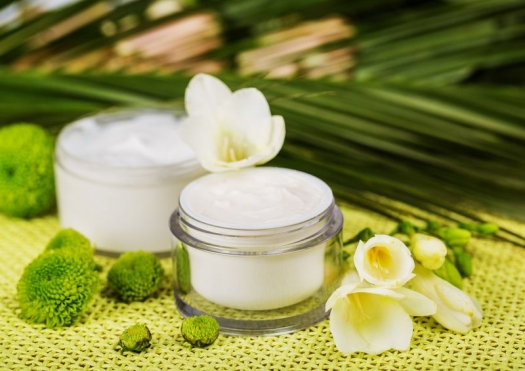SkinCareCream.jpg

Photo by Oleg Dudko, ©2016 / 123rf.com
Skin aging occurs in two ways. Intrinsic aging is driven by genetics and time, while extrinsic aging is the result of environmental factors such as sun exposure. Fortunately, as science is discovering, your skin is wonderfully responsive to the right kind of self-care for both prevention and damage reversal. The trick is to meet your skin's special needs. To do that, it helps to understand two of the biggest causes of aging skin.
Loss of Support: Skin is built on a sponge-like framework of a protein called collagen, which supports the skin and gives the face its youthful, lifted appearance. The chambers of the "sponge" are occupied by a gel-like substance known as glycosaminoglycans (GAGs), which, along with fat, help keep the framework plumped up.
Hard-working cells called fibroblasts, which live in the base of the skin, produce a continuous supply of fresh collagen and fresh GAGs. Fibroblasts also make an enzyme called collagenase, which is supposed to break down old collagen fibers so they can be recycled into new ones – keeping the framework of your skin robust. Scientists have found that the fibroblasts in aging skin still have the ability to manufacture new collagen and new GAGs, but they're not receiving as many of the messages that normally stimulate them to do so.
Meanwhile, they continue to produce collagenase, which continues to dismantle the framework – resulting in a definite imbalance between breakdown and rebuilding. Sun exposure (even if it's not enough to cause sunburn) causes oxidative damage that stimulates even more collagenase and speeds up collapse of the framework, causing wrinkles and droopiness.
Radiation Damage: UV radiation from the sun does two types of damage. UVB radiation, which is absorbed mostly by your cells' DNA, causes sunburn and increases the risk of skin cancer. UVA radiation further damages the DNA, and it also stimulates more enzymatic breakdown of collagen while inhibiting new collagen formation by the fibroblasts.
Protect, Repair, and Rebuild Your Skin
There are some well-known nutrients that have proven to be essential for healthy skin. They include beta-carotene (5,000-25,000 IU daily), vitamin E (400-2,000 IU daily), vitamin C (2,000 mg daily), citrus bioflavonoids (100-300 mg daily), lutein (5-15 mg daily), and grapeseed extract (25-50 mg daily).
These nutrients work together to provide powerful antioxidant protection, collagen preservation and repair, and a protective internal sunscreen. You should view these as a non-negotiable part of your skin protective regimen because, even if you spend a fortune on high-tech skin repair products, your skin won't respond optimally if you are lacking in any of these basic nutrients. Fortunately, you can find many of these nutrients in a good, high-potency multinutrient product and in many skin care supplements.
This month, however, I want to focus on recent research done on nutrients that are proving to go beyond basic nutritional support to significantly enhance a woman's ability to regain and retain more youthful-looking skin.
Lycopene. While the powerful antioxidant beta carotene rightfully belongs in the above list of important nutrients for healthy, young-looking skin, an even more critical member of the carotenoid family for maintaining younger-looking skin is lycopene, which is present in the skin at greater levels than beta carotene. And, when skin gets sunburned, beta carotene levels in the skin change very little, while lycopene levels plummet by nearly half. This means the skin uses lycopene to quench the inflammation and DNA damage caused by the toxic free radicals that are generated from sun exposure.
Studies have confirmed that to protect skin against sun damage – the harshest and most preventable cause of skin aging – lycopene reigns supreme. There is also a direct correlation between declining levels of lycopene and skin roughness. In fact, lycopene levels in the skin are stronger determinants of the smoothness or roughness of a woman's skin than age is! In addition, lycopene significantly improves barrier integrity and anti-inflammatory protection in the cells lining our blood vessels, which are specialized versions of the cells that form our skin. It stands to reason that lycopene is a major player in keeping skin cool, smooth, resilient, and healthy looking.
While most people know lycopene is found in cooked tomatoes, they might not realize it's also abundant as the pigment that makes watermelon red, pink grapefruit pink, and guava pinkish orange. I recommend adding more of these foods to your regular diet, and taking 15 mg daily of supplemental lycopene.
Niacinamide (vitamin B3). Research has established that niacinamide can quickly reduce excessive pigmentation (blotchiness) in aging human skin cells, stimulate more production of the natural skin hydrating agent hyaluronic acid, increase ceramide levels in the skin, reduce fine lines and wrinkles, and increase collagen formation.
My first experience with topical niacinamide was with a patient in her 70s who had several dark spots on one forearm. Her skin was also tissue paper thin. I gave her a sample of a topical niacinamide called NIA24 to try. Three weeks later, she rolled up her sleeves and showed me both forearms. The dark spots were completely gone, and the skin on that arm was thicker, even colored, and healthy looking. I hadn't meant for her to use the cream only on one arm, but the comparison to her other untreated arm really illustrated how well it worked.
Another patient had an age spot just above her upper lip, which people often mentioned to her because they thought it was a smudge of dirt. Once again, I provided a sample of the niacinamide cream and, within three weeks, the discoloration was gone. Some people do experience a brief reddening and hot feeling in the skin after applying niacinamide cream, so I suggest trying it on just a small patch of skin first to see if it bothers you. Try NIA24 Skin Strengthening Complex.
Niacinamide combined with N-acetyl glucosamine. In a recent study, a skin cream that combined niacinamide cream with N-acetyl glucosamine cream was found to reduce pre-existing blotchiness even better than niacinamide alone, while also protecting against UV radiation, as well as an SPF 15 sunscreen (February 2010, British Journal of Dermatology).
Ceramides are a family of lipids that are key components of young human skin. They are responsible for keeping it well hydrated, glowing, and resilient, and giving it the integrity it needs to form an effective barrier against damage from irritants, germs, and allergens. Dermatology researchers call this critical function of skin barrier integrity. Without it, your skin is drier, thinner, and more vulnerable to injury, allergy, and aging.
Studies show that there are at least 11 types of ceramides in human skin, and when the skin falls victim to sunburn, wrinkling, contact allergies, itching, and other problems, loss of barrier integrity is a major cause and a major impediment to successful treatment. The good news is that skin care products that contain ceramides are proven to improve barrier integrity in as little as three weeks. Topical use of ceramides can be very effective.
Two good moisturizers that contain ceramides are Soothing Barrier Repair Moisturizer and Nouriva Repair Moisturizing Cream.
Fern extract. Studies show that when taken as an oral supplement, a water-soluble extract of the leaves of the fern Polypodium leucotomos (which is native to tropical and subtropical regions of North, Central, and South America) not only protects the skin via antioxidant and anti-inflammatory benefits, but also acts as a sunscreen from the inside.
In a recent Italian study, for example, 74 percent of 57 patients suffering from photodermatoses (skin rashes and/or hives when exposed to the sun) had significantly reduced skin reaction after taking 480 mg per day of the extract and then being sun-exposed, even though they used no external sun protection during the study. Just as importantly, they had absolutely no adverse side effects reported (April 2011, Italian Journal of Dermatology). In another study, which was randomized and placebocontrolled, skin biopsies of subjects who took the oral extract and then were sun-exposed to the point of early sunburn showed that they had significantly less of the mitochondrial DNA damage that commonly occurs in sunburned skin cells (March 2010, Journal of the American Academy of Dermatology). Heliocare is one brand that contains this extract.
Inexpensive Exfoliation
Exfoliants not only help remove dead skin cells that weigh down and suffocate aging skin, but also stimulate the production of GAGs, improve skin moisture, and boost the activity of skin-protecting antioxidants. There are countless exfoliation products on the market, but I find that the most effective – and cheapest – way to exfoliate the skin is to use regular aspirin tablets. Simply crush five aspirin tablets, mix in a little warm water to create a paste, and spread on your face and neck. Allow it to dry before rinsing it off with a soft washcloth. Aspirin is not only an anti-inflammatory, but the salicylic acid in aspirin loosens dead skin, revealing fresher, softer skin.
Originally published in Women's Wellness Today, Vol. 18, No. 8, August 2011. Used with permission.


